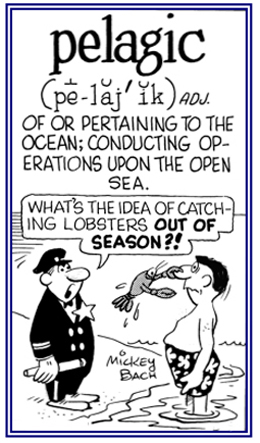neap tide
(s) (noun), neap tides
(pl)
A tide of decreased range that occurs twice a month: A
neap tide takes place when the Moon is in quadrature, that is during its first and last quarters, when the Sun and the Moon are at right angles to each other relative to the Earth.
The neap tide takes place on the Earth when the Sun and Moon are in positions forming a right angle at the Earth's center.
The Sun and Moon largely cancel each other out, resulting in an extra low high tide and an extra high low tide.
nekton (literally, "swimmers")
The larger fish and squids, whose swimming speed considerably exceeds that of the ambient currents.
nutriments
Elements; such as, nitrogen and phosphorus, which are indispensable for plant growth and planktonic production; the ocean's fertilizers.
oligotrophic
1. Pertaining to a nutrient-poor body of water; such as, the central zones of the oceans which have very little plankton.
2. Etymology: from Greek oligo, "few", and trophe, "nourishment".
otolith (literally, "ear stone")
The earbone of a fish.
The age of a fish is commonly estimated by counting the rings laid down annually in the otolith, much as the age of a tree is determined by counting the rings across its trunk.
paleozoic (literally, "ancient life")
The geological era that extends from the dawn of the modern phyla in the Cambrian (about 570 million years ago) to the end of the Permian (about 245 million years ago).
Paralvinella palmiformis, palm worms
Palm worms live in dense colonies around the hydrothermal vents found along the northern section of the Mid-Atlantic Ridge, off the coast of Canada.
Although the surrounding waters are laden with metals that would be lethal to humans, they do not seem to bother the worms.
They form colonies that resemble impregnable bushes, but they don't seem to repel the gastropods and scale worms seem to be dusted with organic and mineral particles.
pelagial
Pertaining to the open sea rather than along a coastline.
pelagian
Descriptive of life that occurs or exists in the upper waters of the seas.
pelagic
(adjective), more pelagic, most pelagic
1. Referring to the fish and animals that live in the open sea far from the shore:
Palagic areas are related to creatures that exist in the expansive bodies of salt water that covers almost three fourths of the earth's surface rather than areas which are adjacent to land or inland rivers or streams.
2. Relating to the ocean or the open sea:
Pelagic habitats differ depending on the water depth in the aquatic areas.
3. Etymology: from Greek
pelagikos, from
pelagos, "the sea".
 © ALL rights are reserved.
© ALL rights are reserved.
Go to this Word A Day Revisited Index
so you can see more of Mickey Bach's cartoons.
perigean tide
A monthly tide of increased range that occurs when the moon is at perigee or closest to the earth.
photic
A reference to a zone, or space, within lakes or oceans that is penetrated by sunlight.
The lower limit of this zone depends on the particles in suspension in the water. In the open sea, it typically extends down to about 200 meters (656 feet).
photophores
Light-producing organs commonly found in mesopelagic organisms.
phylum
One of the largest divisions of the animal or plant kingdoms.
Within the hierarchy of taxonomic classification, a phylum is situated between kingdom and class.
phytoplankton
Planktonic organisms belonging to the plant kingdom.
Many of them are microscopic algae and diatoms (unicellular organisms) that photosynthesize, producing the first level in the ocean's food chain.
Index of additional Scientific and Technological Topics.



